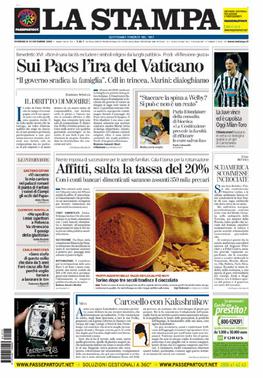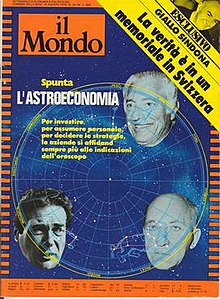
Corriere della Sera is an Italian daily newspaper published in Milan with an average circulation of 246,278 copies in May 2023. First published on 5 March 1876, Corriere della Sera is one of Italy's oldest newspapers and is Italy's most read newspaper. Its masthead has remained unchanged since its first edition in 1876. It reached a circulation of over 1 million under editor and co-owner Luigi Albertini between 1900 and 1925. He was a strong opponent of socialism, clericalism, and Giovanni Giolitti, who was willing to compromise with those forces during his time as prime minister of Italy. Albertini's opposition to the Italian fascist regime forced the other co-owners to oust him in 1925.

Panorama is a weekly Italian-language news magazine published in Italy and based in Milan.

la Repubblica is an Italian daily general-interest newspaper with an average circulation of 151,309 copies in May 2023. It was founded in 1976 in Rome by Gruppo Editoriale L'Espresso and led by Eugenio Scalfari, Carlo Caracciolo, and Arnoldo Mondadori Editore as a leftist newspaper, which proclaimed itself a "newspaper-party". During the early years of la Repubblica, its political views and readership ranged from the reformist left to the extraparliamentary left. Into the 21st century, it is identified with centre-left politics, and was known for its anti-Berlusconism, and Silvio Berlusconi's personal scorn for the paper.

La Stampa is an Italian daily newspaper published in Turin with an average circulation of 87,143 copies in May 2023. Distributed in Italy and other European nations, it is one of the oldest newspapers in Italy. Until the late 1970s and early 1980s, when the country underwent a nationalization process, La Stampa and Corriere della Sera were not real national daily newspapers, as their geographical area of circulation was mostly limited to Piedmont for La Stampa and Lombardy for Corriere della Sera; thus, both papers shared a readership that was linked to its place of residence and its social class, mostly from the industrialist class and financial circles. La Stampa has "historically" been Turin's newspaper of record. It is considered one of Italy's leading national newspapers alongside Corriere della Sera, la Repubblica, Il Sole 24 Ore, and Il Messaggero.
il Giornale, known from its founding in 1974 until 1983 as il Giornale nuovo, is an Italian-language daily newspaper published in Milan with an average circulation of 28,933 copies in May 2023. In 2006, it was considered one of Italy's main national newspapers in Italy.

Ennio Flaiano was an Italian screenwriter, playwright, novelist, journalist, and drama critic. Best known for his work with Federico Fellini, Flaiano co-wrote ten screenplays with the Italian director, including La Strada (1954), La Dolce Vita (1960), and 8½ (1963).
Italy–USA Foundation is a non-profit non-partisan organization based in Rome, Italy, established to promote friendship between Italians and Americans plus American culture in Italy.
The Corriere dei Piccoli, later nicknamed Corrierino, was a weekly magazine for children published in Italy from 1908 to 1995. It was the first Italian periodical to make a regular feature of publishing comic strips.

Carmen Scarpitta was an Italian stage and film actress. She appeared in 30 films between 1960 and 2001.

Il Giorno is an Italian-language national daily newspaper, based in Milan, Italy; it has numerous local editions in Lombardy.

Arrigo Benedetti was an Italian journalist and writer. He was also the editor of important news magazines: Oggi (1939–1941), L'Europeo (1945–54), L'Espresso (1955–63), and Il Mondo (1969–72). Born as Giulio, he changed his name to Arrigo in 1933.

Massimo Giletti is an Italian television presenter, television writer and journalist.
Sette, also known as Corriere della Sera Sette, is a news, political and lifestyle magazine based in Milan, Italy. The magazine is the weekly supplement of the daily newspaper Corriere della Sera. It was the first colour supplement distributed with a daily paper in Italy.
Il Borghese is a monthly cultural and political magazine with a right-wing stance published in Rome, Italy. The magazine has been in circulation since 1950 and is named after the conservative Borghese family.

Leopoldo "Leo" Longanesi was an Italian journalist, publicist, screenplayer, playwright, writer, and publisher. Longanesi is mostly known in his country for his satirical works on Italian society and people. He also founded the eponymous publishing house in Milan in 1946 and was a mentor-like figure for Indro Montanelli.
Mario Pannunzio was an Italian journalist and politician. As a journalist he was the director in charge of the daily newspaper Risorgimento Liberale in the 1940s and of the weekly political magazine Il Mondo in the 1950s. As a politician he was a co-founder of the revived Italian Liberal Party in the 1940s and then of the Radical Party in 1955.
Domenico Bartoli was an Italian journalist and essayist. In 1960 he became the director of Il Resto del Carlino, a Bologna-based mass-circulation daily newspaper, remaining in the position for ten years.
Vittorio Gorresio was an Italian Journalist-commentator and essayist.
Omnibus was a weekly illustrated general cultural magazine published in Milan, Italy, between 1937 and 1939. Its subtitle was settimanale di attualità politica e letteraria. It is described as the "father of Italian magazines", especially in regard to the use of photographs and images. The magazine was closed by the fascist authorities.

Adolfo Battaglia is an Italian journalist who served as the minister of industry, commerce and craftsmanship between 1987 and 1991 in three successive cabinets. He was a long-term member of the Chamber of Deputies.











